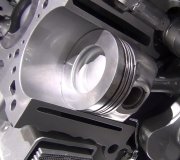1983 Mitsubishi Mighty Max 4 cyl Two Wheel Drive Automatic 125K miles
I have a 1983 Mitsubishi Pickup – 2.6L; 4-cyl; 2wd; Automatic (125,000 miles) that I have just completed a major engine overhaul which included a installing a new cylinder head, rebuilt carburetor, and distributor. I’ve been able to get the engine running, but I’m having a problem trying to “tune the engine". With the idle rpm set correctly, the engine will start and run only if ignition timing is 7-10 degrees ATDC with the vacuum advance disconnected (spec is 5-9 degrees BTDC). When I adjust the timing to the specification, the idle speed increases beyond specification, roughly 1100-1300 rpm. This causes port vacuum to operate, which if connected to the vacuum advance on the distributor, would cause timing to be too far advanced. When I adjust the speed screw downward to get it in spec, the engine starts to idle erratically and then dies. It’s almost acting as if the truck is running in a sort of “open loop mode", but there isn’t an ECU on this truck. I’ve tried setting the timing using the procedure in the shop manual, but if I do that, it won’t start at all. Incidentally, I also had the same problem when I re-used the original distributor and control unit.
I’ve doubled and tripled checked the valve timing to make sure that it is correct and all the valve clearances are in specification. If I can’t get the idle rpm and ignition timing within specification, it will never pass smog here in California.
The original cause of the engine repair was an overheating event causing the cylinder head to warp and lose compression. During the overhaul, I didn’t take the crankshaft out or remove the timing chain and cam sprocket as I didn’t think at the time, there was a need to. It doesn’t seem likely that these would be the cause unless the chain is bad (it’s the original chain). I’ve also tested and ruled out vacuum leaks, both from external devices and the mating surfaces of intake manifold to cylinder and carburetor to manifold.
Part of the problem I have is that I do not have good information on the Mikuni carburetor. The shop manual I have does not cover what all screw adjustments there are on the carb and I haven’t found information on the internet.
I’ve also noticed on my particular truck, there is an engine speed sensor and relay as well as a speed control unit. I know a malfunction in the speed sensor can affect timing, but again, my shop manual does not cover where it is or how to test it. It is also silent on the speed control unit.
Any ideas or information you have that could help me would be greatly appreciated.
Sunday, October 31st, 2010 AT 6:48 PM


